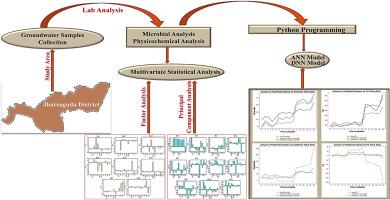A sustainable approach to evaluating groundwater contamination in the Jharsuguda district, Odisha, India, using a multivariate statistical approach, modelling, and viable remedial measures
IF 4.1
3区 地球科学
Q2 GEOSCIENCES, MULTIDISCIPLINARY
引用次数: 0
Abstract
This study was carried out by collecting groundwater samples from various important locations in the Jharsuguda district, Odisha, India. From physicochemical parameters, it was found that the groundwater in most of the areas is heavily contaminated. From the study of bacteriological analysis, it was observed that only five groundwater samples from the residential colony area are contaminated by fecal coliform. Using a scree plot, PCA extracted the first three components with 69.19 %, 18.39 %, and 7.99 % of variance and retained the maximum variation of the data set. Only eight variables were responsible for 99.9 % of the cumulative percentage of variance based on FA. From the comparative analysis, it was found that the performance of a deep neural network (DNN) is comparatively more consistent and clearer than an artificial neural network (ANN) model in predicting the targeted outputs. From the DNN model, the R2 value is 0.91, which shows that there is a good variance in the observed data, but in the ANN model, the R2 value is 0.79. The purpose of this study is to identify the major pollutants that cause groundwater contamination, investigate pollution trends, and provide credible forecasting tools to help prevent groundwater contamination and provide sustainable resource management. This work facilitates clear understanding regarding the level of contamination of groundwater and specific pollutants that are maximally responsible for the contamination. It also promotes public wellness and sustainable water management in the study area. To remove fecal coliform, chlorination is suggested to be the most viable process.

利用多元统计方法、建模和可行的补救措施,对印度奥里萨邦Jharsuguda地区的地下水污染进行可持续评价
这项研究是通过在印度奥里萨邦Jharsuguda地区的不同重要地点收集地下水样本进行的。从理化参数分析发现,大部分地区地下水污染严重。从细菌学分析的研究中发现,只有5个居住菌落区地下水样品被粪便大肠菌群污染。PCA利用屏幕图提取方差分别为69.19%、18.39%和7.99%的前三个分量,保留了数据集的最大方差。只有8个变量对基于FA的累积方差百分比的99.9%负责。通过对比分析,发现深度神经网络(DNN)在预测目标输出方面的表现相对于人工神经网络(ANN)模型更为一致和清晰。从DNN模型来看,R2值为0.91,说明观测数据有很好的方差,而在ANN模型中,R2值为0.79。本研究的目的是识别导致地下水污染的主要污染物,调查污染趋势,并提供可靠的预测工具,以帮助预防地下水污染和提供可持续的资源管理。这项工作有助于清楚地了解地下水的污染水平和对污染负有最大责任的特定污染物。它还促进了研究区域的公共健康和可持续水管理。为了去除粪便大肠菌群,氯化是最可行的方法。
本文章由计算机程序翻译,如有差异,请以英文原文为准。
求助全文
约1分钟内获得全文
求助全文
来源期刊

Physics and Chemistry of the Earth
地学-地球科学综合
CiteScore
5.40
自引率
2.70%
发文量
176
审稿时长
31.6 weeks
期刊介绍:
Physics and Chemistry of the Earth is an international interdisciplinary journal for the rapid publication of collections of refereed communications in separate thematic issues, either stemming from scientific meetings, or, especially compiled for the occasion. There is no restriction on the length of articles published in the journal. Physics and Chemistry of the Earth incorporates the separate Parts A, B and C which existed until the end of 2001.
Please note: the Editors are unable to consider submissions that are not invited or linked to a thematic issue. Please do not submit unsolicited papers.
The journal covers the following subject areas:
-Solid Earth and Geodesy:
(geology, geochemistry, tectonophysics, seismology, volcanology, palaeomagnetism and rock magnetism, electromagnetism and potential fields, marine and environmental geosciences as well as geodesy).
-Hydrology, Oceans and Atmosphere:
(hydrology and water resources research, engineering and management, oceanography and oceanic chemistry, shelf, sea, lake and river sciences, meteorology and atmospheric sciences incl. chemistry as well as climatology and glaciology).
-Solar-Terrestrial and Planetary Science:
(solar, heliospheric and solar-planetary sciences, geology, geophysics and atmospheric sciences of planets, satellites and small bodies as well as cosmochemistry and exobiology).
 求助内容:
求助内容: 应助结果提醒方式:
应助结果提醒方式:


